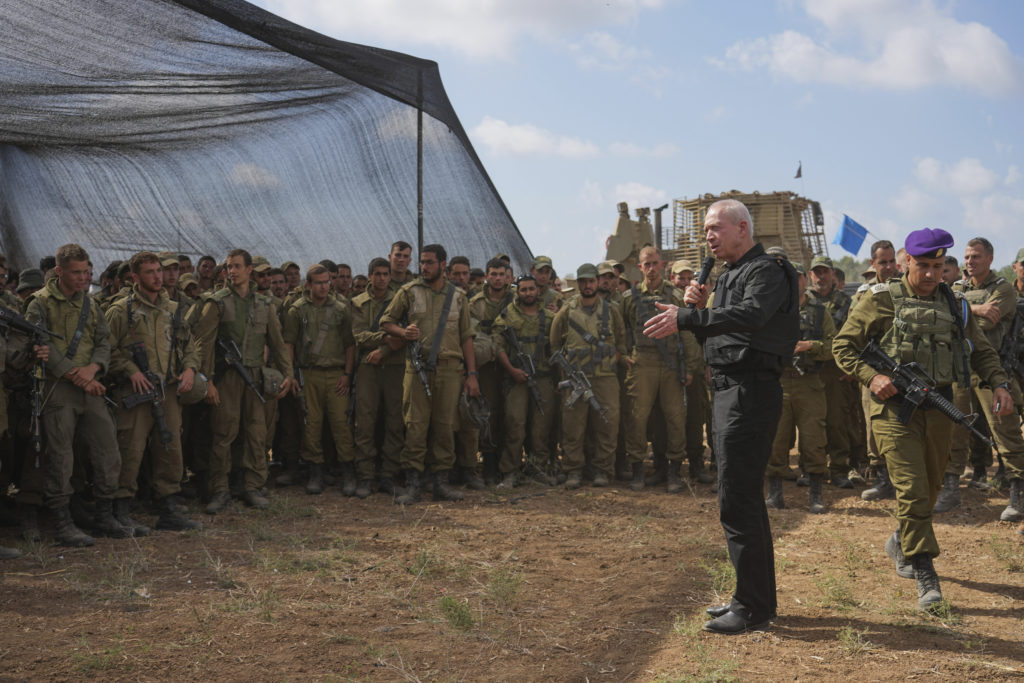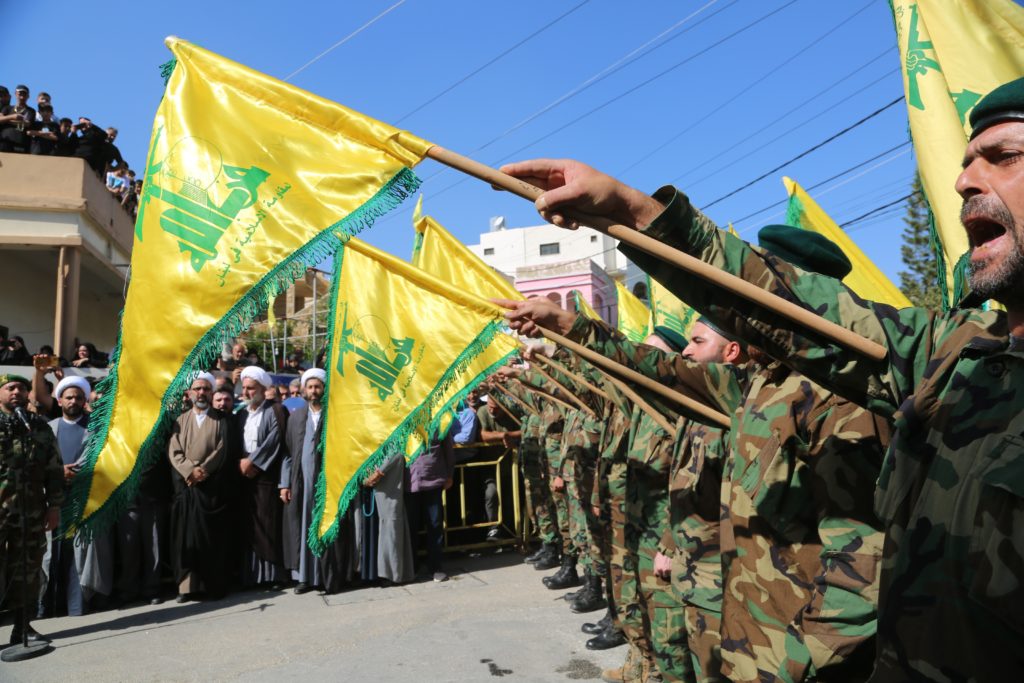Australia/Israel Review
Hezbollah war threatens as Gaza war declines
Jan 24, 2024 | Ilan Evyatar

On January 14, Israel marked 100 days since the Gaza War began with the Hamas mass attacks of October 7, with an end game remaining far from sight, and a wider war in the north with Hezbollah still very much a possibility.
In Gaza, the Israel Defence Forces (IDF) has begun to thin out its forces in the northern part of the Strip as it transitions to a “lower-intensity phase of fighting” under American pressure. Defence Minister Yoav Gallant said this new phase would include commando raids and operations to destroy Hamas tunnels and infrastructure.
In southern Gaza, Israel continues to fight heavy battles as it targets Hamas leaders who are believed to be hiding out deep under the city of Khan Younis, where the most intense fighting is taking place. The Islamic terror group is still holding 136 Israeli hostages, many of whom are believed to be in the tunnels under Khan Younis, while some are known to have been killed.
Speaking on Jan. 16, Gallant said that Israel would soon transition to a lower-intensity phase in southern Gaza as well. Nevertheless, Israel, for the moment, appears to be still a long way from achieving its goals, defined by Prime Minister Binyamin Netanyahu in a speech marking 100 days since the October 7 massacre as being “to eliminate Hamas, return our hostages and that Gaza will no longer remain a threat to Israel.”
The IDF issued a slew of statistical data to mark 100 days of fighting: Since October 7, Israeli forces have struck some 30,000 Hamas targets and eliminated an estimated 9,000 of its fighters, with thousands more injured; 50 Hamas company commanders have been killed along with 19 battalion commanders and two brigade commanders. Despite these numbers, the IDF expects the fighting to continue for most of 2024 as it seeks to slowly grind down Hamas, stripping it of asset after asset and closing in on its underground strongholds. Declaring victory remains a long way off.
Meanwhile, negotiations on a hostage deal have gone nowhere since the initial swap in mid-November. Hamas continues to insist that it will not accept any deal that does not include the release of all Palestinian security prisoners and a complete cessation of hostilities – the latter demand being completely unacceptable to Israel.
Over 100,000 Israelis marked the anniversary with a rally at Hostage Square – the renamed plaza outside the Tel Aviv Museum of Art – to call on the Government to do “everything possible” to bring the hostages back home.
Hamas marked the anniversary with rocket salvos across southern Israel and psychological warfare, including announcing the deaths of two more hostages.
Israeli artist Roni Levavi erected a 30-metre-long claustrophobic, dimly lit, concrete tunnel installation at the plaza, simulating the dire conditions in which the hostages are held, replete with bare electric wiring, eerie echoes and the sound of gunfire and shelling. As visitors emerge, they see the light at the end of the tunnel; will that be the case for the hostages in Gaza?
As the fighting in Gaza moves to a lower-intensity phase, on Israel’s northern border with Lebanon, tensions have spiralled and the risk of a wider war with Hezbollah grows by the day.
For the first three months of the war, Gaza was Israel’s priority, which initially allowed Hezbollah to dictate the tempo as it struck the northern border area daily in support of Hamas. Now Israel appears to have taken the initiative. On Jan. 2, Israel, according to foreign reports, assassinated the number two in Hamas’ political bureau, Saleh al-Arouri, in an air strike on the Dahiya neighbourhood of Beirut, a Hezbollah stronghold. This was followed up a few days later with a drone strike that eliminated Wissam al-Tawil, a senior Hezbollah commander, while another such strike near al-Tawil’s funeral took out the commander of Hezbollah’s aerial forces. Israel took responsibility for both hits. Earlier, on Dec. 25, it also assassinated a senior Islamic Revolutionary Guards Corps (IRGC) officer, Sayyed Razi Mousavi, who served as a conduit for the transfer of arms between Iran, Syria and Hezbollah.
On Jan. 16, Israel launched the heaviest attacks inside Lebanon since hostilities erupted in the north, launching 16 bombing raids in succession on Hezbollah assets in the Saluki Valley in southern Lebanon.
While senior Israeli military sources insisted in the wake of that attack that war with Hezbollah was not inevitable, it appears that Israel is now more likely to initiate a major conflict with Hezbollah than the other way round. With close to 100,000 people displaced from communities along the northern border, Israel has warned that it will not accept a return to the pre-October 7 situation wherein Hezbollah sits right on the border.

Hezbollah had been dictating the tempo of clashes on Israel’s northern border, but recent events suggest Israel is trying to take the initiative (Image: Shutterstock)
While it was Hamas that launched an invasion of Israel on October 7, Hezbollah has declared for years that it would attempt to seize Israeli territory and invade Israeli communities in the event of a conflict. Given that fear, Israel is now demanding that Iran’s Lebanese proxy pull back beyond the Litani River, a few kilometres north of the border, as required by UN Security Council Resolution 1701, reached after the Second Lebanon War in 2006 but never implemented.
The Biden Administration has dispatched a senior envoy, Amos Hochstein, to the region to try to negotiate a diplomatic settlement that would see Hezbollah pull back in exchange for a settlement of several small border disputes between the Lebanese government and Israel. In 2022, Hochstein successfully brokered a maritime border agreement between the two countries to settle gas drilling rights.
Israel has warned that if these latest diplomatic efforts fail, it could resort to a military operation. “We prefer the path of an agreed-upon diplomatic settlement,” said Defence Minister Gallant, “but we are getting close to the point where the hourglass will turn over.” Gallant was reportedly in favour of a pre-emptive strike on Hezbollah in October following Hamas’ incursion into Israel.
Overall, Hezbollah represents a much greater threat to Israel than Hamas; it possesses a far larger and far deadlier and more accurate missile arsenal and has well-trained and battle-hardened ground forces. The question is, does Israel have the stamina for another war in the north as it continues to fight, albeit at a lower tempo, a major conflict in Gaza?
One piece of good news for Israel at this time is that the Abraham Accords have survived their first major test – with both the United Arab Emirates and Bahrain making it clear that peace with Israel was a “strategic decision, and strategic decisions are long-term.” Even more importantly, despite the anger on the Arab street and the caustic rhetoric employed against Israel from Riyadh during the current war, normalisation between Israel and Saudi Arabia appears to still be on the table.
If one of the goals of the “Al-Aqsa Flood” – the name given by Hamas to its October 7 operation – was to tank any possibility of normalisation between Israel and Saudi Arabia, as many analysts have speculated, that appears to have failed.
Both American and Saudi officials have said publicly that normalisation can still happen, but both have stressed that a road map to a two-state solution and a political horizon for the Palestinians will be required for it to materialise.
Shortly before the Gaza war, normalisation looked to be pretty much a done deal, even without major concessions by Israel to the Palestinians. Saudi Crown Prince Mohammed Bin Salman said in September 2023 that Israel and Saudi Arabia were “moving closer by the day.” Israel and the US were pushing hard for a deal to happen by mid-February 2024, before the American election schedule would make a complex trilateral deal all but impossible to complete. That time frame is now out of the question both because of US domestic considerations and because the Saudis will want to wait for the dust to settle before moving ahead.
In any event, Riyadh has certainly raised its price. Israel’s ruling coalition, currently unable to conduct even a meaningful discussion on the “day after” in Gaza due to major internal divisions, will eventually have to decide whether it is willing to pay.






